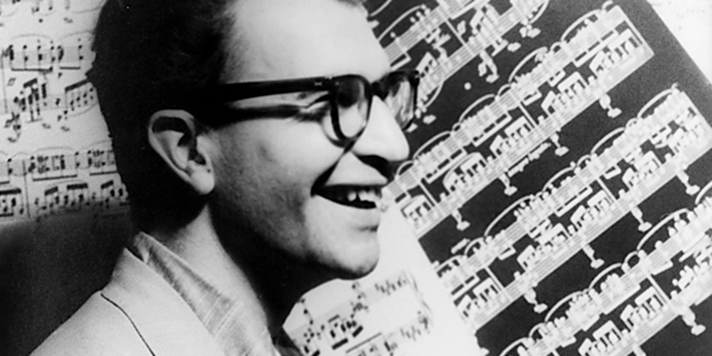Pianist Dave Brubeck has been lauded as one of the most influential jazz artists of the 1950s and 60s. As cool jazz began to reach its prime, Brubeck succeeded in finding an audience for his more complex music (both tonally and time signature-wise).
Born in Concord, California, on December 6, 1920, David Warren Brubeck was immersed in a musical environment from an early age. His mother was a classically trained pianist and both of his older brothers would become professional musicians. At the age of 4, he began piano lessons and with a good ear, he was able to hid the fact that he wasn’t good at reading music for quite some time (it wasn’t until he was in college that his teachers found out he couldn’t read music).
In his teen years, Brubeck performed with a local dance band, but unlike many of his musician contemporaries, he continued through school to study veterinary medicine. He enrolled at the College of the Pacific in Stockton, California, playing locally to help pay for his education.
During WWII, Brubeck was drafted into the army where he served under General George S. Patton. He was asked to play piano for troops by the Red Cross which saved him from having to fight in the Battle of the Bulge. He later formed a jazz group with fellow soldiers called “The Wolfpack.”
After being honorably discharged in 1946, he re-enrolled in university at Mills College in Oakland, California where he studied with Darius Milhaud. This is arguably where Brubeck was inspired to incorporate unusual time signatures into his compositions.
He debuted the Dave Brubeck Quartet in 1951 with Paul Desmond on sax, and a rotating rhythm section. In 1956, Joe Morello became the permanent drummer and in 1958, Eugene became the steady basis.
The popularity of the group’s records led to their touring college campuses across the US. In 1954, Brubeck became the second jazz musician to grace the cover of Time Magazine (after Louis Armstrong).
In 1959, Brubeck released his most adventurous and ambitious albums, “Time Out” which featured a collection of tunes written in unusual time signatures like 5/4 and 9/8. His label, Columbia, were worried about releasing the album, but thankfully they went through with the release. It sold more than a million copies (the first jazz album to do so), and it attained a position at #25 on the Pop Charts.
He continued to do several projects, and even formed a fusion/rock group with his sons in the 1970s called Two Generations of Brubeck.
Brubeck received several awards recognizing his contributions to jazz including a star on the Hollywood Walk of Fame, a lifetime achievement Grammy, a Smithsonian Medal, and at least five honorary degrees from universities around the world.
He passed away from heart failure in 2012 on December 5. It was one day before what would have been in 92nd birthday. Some of his notable works include “Take Five” and “Blue Rondo à la Turk”.
[template id=”182″]


